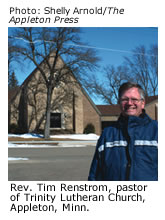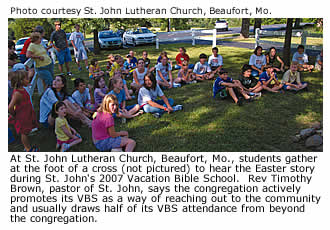by Roland Lovstad
Sometimes we discover the most striking information in our own backyards.
 At a conference last fall, Dana Spry, a member of Trinity Lutheran Church in Appleton, Minn., heard that, on average, half the people in rural communities across the country are unchurched. So he tested the information. Spry contacted all the churches in Appleton, a community of 2,800 about 150 miles west of Minneapolis, and tabulated their worship attendance. He discovered that only a third of Appleton’s residents attended church on any given Sunday.
At a conference last fall, Dana Spry, a member of Trinity Lutheran Church in Appleton, Minn., heard that, on average, half the people in rural communities across the country are unchurched. So he tested the information. Spry contacted all the churches in Appleton, a community of 2,800 about 150 miles west of Minneapolis, and tabulated their worship attendance. He discovered that only a third of Appleton’s residents attended church on any given Sunday.
“There is an age-old attitude that this is Minnesota, where everybody goes to church,” says Trinity’s pastor, Rev. Tim Renstrom. “The truth is different than that: The truth is that at least half the people we see have no church connection.”
In Missouri, Rev. Timothy Brown describes a meeting of pastors from rural and small-town congregations. The topic of conversation: Often, small-town churches see themselves as having little value, especially when attention seems focused exclusively on the activities of suburban megachurches with thousands of members.
Brown, now serving his fourth small-town congregation during his 19-year career, recalls such a “down” attitude when he came to St. John in Beaufort nearly seven years ago. “Every time a family left, it was ‘we’re going downhill.’ It was kind of in the air. No one said anything, but you knew,” he recalls.
The experiences in congregations such as Trinity and St. John are reminders of the potential for mission and ministry in rural and small-town congregations. A statistical study of 24 “heartland districts” of The Lutheran Church—Missouri Synod found that 60 percent of LCMS congregations are in communities of less than 15,000. The information was gathered from the 2008 Lutheran Annual by the Saint Paul Institute for Education (SPIFE) in Concordia, Mo.
“The primary challenge is change and transition,” explains Dr. Ralph Geisler, SPIFE interim director. Geisler presents the rural ministry leadership-training program SPIFE offers at its learning center at Saint Paul Lutheran High School in Concordia, where the institute has its headquarters. He also takes the program “on the road” throughout the heartland.
The program for rural and small-town congregations is divided into modules that can be presented separately or as part of a complete cycle.
“The challenge is more the restoration of a positive attitude,” observes Geisler. “We are all created by God and someone for whom our Savior died. Regardless of where we live, we are valued, and the ministry of every congregation, however limited, is to be treasured.”
Geisler developed the modules with Rev. Keith Christiansen, then SPIFE executive director, after conducting “listening posts” in 2001 with leaders from five heartland districts.
Geisler believes self-esteem issues can be strong inhibitors in rural or small-town congregations, especially when congregations fall into a survival mode of thinking. Congregations need to validate their role of ministry in their communities, he says. The SPIFE workshops strive to shift attitudes from survival and maintenance to mission-outpost thinking.
“If you consider that half your neighbors may have no regular church home, then your hometown may be just as much a mission fi eld as a community half a world away,” Geisler says.
The SPIFE modules also focus on relationships, especially nurturing open communication in congregations and towns where families are often very connected. Other modules focus on stabilizing pastoral and lay leadership and on service.
 Renstrom concurs: “Often, in small towns, we associate families with a particular church home. What we discover is that, while Grandpa and Grandma may have attended the Methodist church, or the Baptist church, or another congregation in town, the kids haven’t set foot inside a church in 20 years, and the grandchildren have no church affiliation whatsoever.”
Renstrom concurs: “Often, in small towns, we associate families with a particular church home. What we discover is that, while Grandpa and Grandma may have attended the Methodist church, or the Baptist church, or another congregation in town, the kids haven’t set foot inside a church in 20 years, and the grandchildren have no church affiliation whatsoever.”
“That’s something that is very hard for people to grasp,” Geisler says.
While demographic studies can make that point, Geisler also asks his workshop participants if they have brothers, sisters, or family members who don’t attend church regularly. “It’s pretty eye-opening when they all say ‘yes,’ and we ask, ‘How do we work with that?’” he observes.
Renstrom says Trinity has taken a while to recognize its unchurched community. Witnessing workshops and mission trips have helped members become more comfortable sharing their faith. “It’s easier to practice where nobody knows us and then come back here and try to do it,” he says.
In addition to Renstrom and Spry, Trinity member Dennis Munsterman also attended the SPIFE conference on rural and small-town ministry last fall. “So it’s two people, not just the pastor, saying these kinds of things,” he says. “God is putting these pieces together to slowly, but firmly, move us to be an inviting congregation where people will gladly come to hear and learn God’s Word.”
Sometimes, Renstrom admits, he would like to see things move faster. Then, he says, he prays, “Lord forgive me my sins, especially when I have tried to move Your people when they’re not ready, and I have been cross when You, Yourself, are moving them.”
At such times, Renstrom adds, we also need to remember that, ultimately, it is the Holy Spirit who brings people to faith in Jesus Christ.
In Missouri, Brown says his congregation is beginning to understanding that it is a vital part of Christ’s mission in its community and a vital part of the larger church.

“I don’t like to see people leave, but it’s the people here who are important,” he adds. “We developed an attitude that the church is not here for me; we’re here for each other. This is not a place to feel bad; it’s a place where you will feel good.”
Brown says St. John emphasizes that people have a daily opportunity to witness to the ongoing love of Jesus Christ and to tell of what God has done for them. “You balance inreach and outreach. If you’re only serving yourselves, you’re falling short.
“It’s not a one-man show,” Brown continues. “It takes everybody, and we have worked at it. We understand we are working for the good of the church, the good of the members. A pastor can destroy a congregation, but a pastor cannot build up a congregation by himself; it takes people. We strive to plant the seed, and we pray that the Holy Spirit will use our work to make that seed grow in the hearts of our friends and neighbors, and our community.”
A District President Looks at Rural Challenges
Regardless of whether rural communities are growing or declining, there is an increase in the number of unchurched or uncommitted people, observes Rev. Russell Sommerfeld, president of the Synod’s Nebraska District.
“The challenge is connecting with many of these people,” says Sommerfeld (at computer), pictured here with Minnesota South and Missouri District presidents Lane Seitz (back) and Raymond Mirly. While young residents may move to larger cities, other families move into small communities where they are not related to anyone. Frequently, both husband and wife commute to jobs in larger communities, so congregations have to engage these families on evenings and weekends, Sommerfeld says.
For an expanded look at Sommerfeld’s observations click here. For a snapshot of the Saint Paul Institute for Education, click here.





